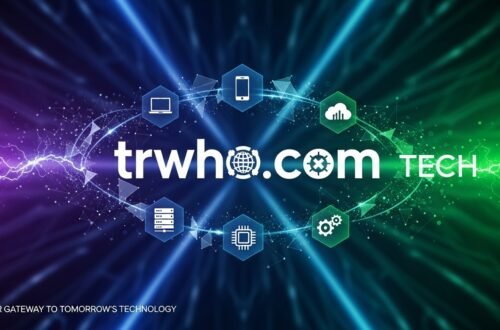Understanding LNA2U9H2F1K7
LNA2U9H2F1K7 is a term that has garnered attention in various fields, particularly in technology and data analysis. Originating from complex algorithms, LNA2U9H2F1K7 serves as a significant tool that enhances the efficiency and accuracy of data processing tasks. Its core functionality revolves around facilitating advanced computational methods that allow users to unlock valuable insights from large datasets.
The relevance of LNA2U9H2F1K7 in today’s context cannot be overstated. As industries continue to generate colossal amounts of data, the need for effective processing mechanisms becomes paramount. LNA2U9H2F1K7 plays a crucial role in enabling organizations to harness this data, providing a framework that ensures robustness and reliability in analysis. Furthermore, it supports various applications across sectors such as healthcare, finance, and engineering, making it a versatile asset in contemporary technological landscapes.
One of the key aspects of LNA2U9H2F1K7 lies in its ability to adapt and evolve. As new challenges arise in data interpretation and analysis, LNA2U9H2F1K7 remains at the forefront, innovating its methodologies to meet the changing demands of users. It also fosters collaboration among professionals, enhancing the exchange of ideas and techniques that drive progress in the field.
In summary, an understanding of LNA2U9H2F1K7 is essential for recognizing its significance in today’s data-driven world. By laying a solid foundation regarding its origins, functionalities, and relevance, we can facilitate deeper discussions on its practical applications and implications in subsequent sections of this blog post.
Applications of LNA2U9H2F1K7
The concept of LNA2U9H2F1K7 has found practical applications across various sectors, showcasing its versatility and effectiveness. In the field of technology, LNA2U9H2F1K7 is utilized to enhance system efficiencies, optimize resource allocation, and improve overall performance. For instance, industries leveraging advanced data analytics have begun to implement LNA2U9H2F1K7 strategies to derive actionable insights from large datasets, resulting in streamlined operations and heightened productivity.
In healthcare, the potential of LNA2U9H2F1K7 continues to emerge, with healthcare providers adopting this approach to enhance patient care. By integrating LNA2U9H2F1K7 methodologies into clinical workflows, medical professionals can improve diagnosis accuracy, personalize treatment plans, and ultimately, achieve better health outcomes for patients. This transformative application is also evident in telemedicine, where LNA2U9H2F1K7 tools help bridge geographic distances, providing patients with access to timely medical services.
The manufacturing sector has also embraced LNA2U9H2F1K7, particularly in the realm of automation and predictive maintenance. Manufacturers are increasingly turning to LNA2U9H2F1K7 solutions for real-time monitoring of equipment performance. This proactive approach not only minimizes downtime but also leads to considerable cost savings while maximizing output. Similarly, the application of LNA2U9H2F1K7 in supply chain management has revolutionized logistics, empowering businesses to forecast demand more accurately and adjust accordingly.
Emerging trends suggest that LNA2U9H2F1K7 will continue to shape various industries in the coming years. For example, its integration with artificial intelligence and machine learning could lead to enhanced decision-making processes across sectors. Companies are beginning to explore innovative ways to harness LNA2U9H2F1K7 for improved customer engagement and innovative product development. These trends hint at the significant future potential of LNA2U9H2F1K7, emphasizing its role as a crucial driver of growth and evolution within diverse domains.

Challenges and Considerations
Engaging with LNA2U9H2F1K7 presents various challenges and considerations for both individuals and organizations. One primary challenge is the complexity associated with implementing this technology, which often requires specialized skills and knowledge. This complexity can lead to misunderstandings and misapplications, potentially diminishing the intended benefits of LNA2U9H2F1K7. Organizations may struggle to find personnel who are adequately trained, which can result in inefficiencies and increased costs.
Another common pitfall involves data privacy and security concerns. With the growing reliance on LNA2U9H2F1K7, organizations face heightened risks of data breaches and unauthorized access. It is essential for businesses to adopt stringent data protection measures and comply with legal frameworks to mitigate these risks. Ethical considerations also come into play, as organizations must evaluate the broader impacts of implementing LNA2U9H2F1K7 on their workforce and customer relations. Ensuring transparency and maintaining trust with stakeholders is crucial to navigating these ethical dilemmas.
Additionally, as with any emerging technology, there is a need to remain vigilant against rapid changes in the market or regulatory landscape. Keeping abreast of the latest developments in LNA2U9H2F1K7 can help organizations adapt and avoid obsolescence. Establishing a culture of continuous learning and staying informed about best practices is vital.
To navigate these challenges effectively, organizations should consider adopting a structured approach that involves thorough planning and evaluation before integrating LNA2U9H2F1K7 into their operations. Engaging in stakeholder consultations, conducting risk assessments, and investing in employee training can enhance readiness and acceptance of this technology. By addressing these challenges proactively, individuals and organizations can unlock the full potential of LNA2U9H2F1K7 while minimizing associated risks.
The Future of LNA2U9H2F1K7
As we look ahead to the future of LNA2U9H2F1K7, it is essential to recognize the rapid advancements anticipated within this framework. The landscape of technology and its intersection with business practices are continually evolving, and LNA2U9H2F1K7 is poised to play a crucial role in this transformation. As industries adapt to novel technologies, the implications of LNA2U9H2F1K7 in sectors such as healthcare, finance, and education cannot be overstated. Emerging trends suggest substantial investments in LNA2U9H2F1K7 capabilities, which promise to enhance productivity and innovation.
In healthcare, for instance, LNA2U9H2F1K7 is expected to improve patient outcomes through more precise diagnostic tools and personalized treatment plans. Financial services will likely leverage LNA2U9H2F1K7 to streamline operations, enhance risk assessment, and facilitate more secure transactions. The education sector can utilize LNA2U9H2F1K7 in developing adaptive learning technologies, enabling customized educational experiences that cater to individual student needs.
Insights from thought leaders in these domains highlight a growing consensus around the transformative potential of LNA2U9H2F1K7. Experts advocate for ongoing collaboration among industries to better harness the full capabilities of this technology. This collaboration is fundamental not only for knowledge sharing but also for addressing ethical concerns and regulatory considerations that may arise as LNA2U9H2F1K7 continues to evolve.
To optimize one’s engagement with LNA2U9H2F1K7, staying informed through reputable sources, attending industry conferences, and participating in relevant forums can be beneficial. Encouraging dialogue among stakeholders and adapting to changes as they unfold are critical steps toward embracing the future of this promising technology. The journey is just beginning, and by actively engaging with these advancements, individuals and organizations can ensure they remain at the forefront of innovation.





